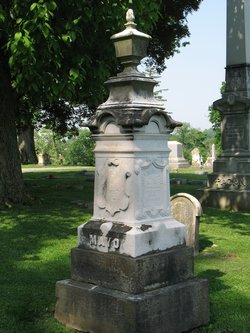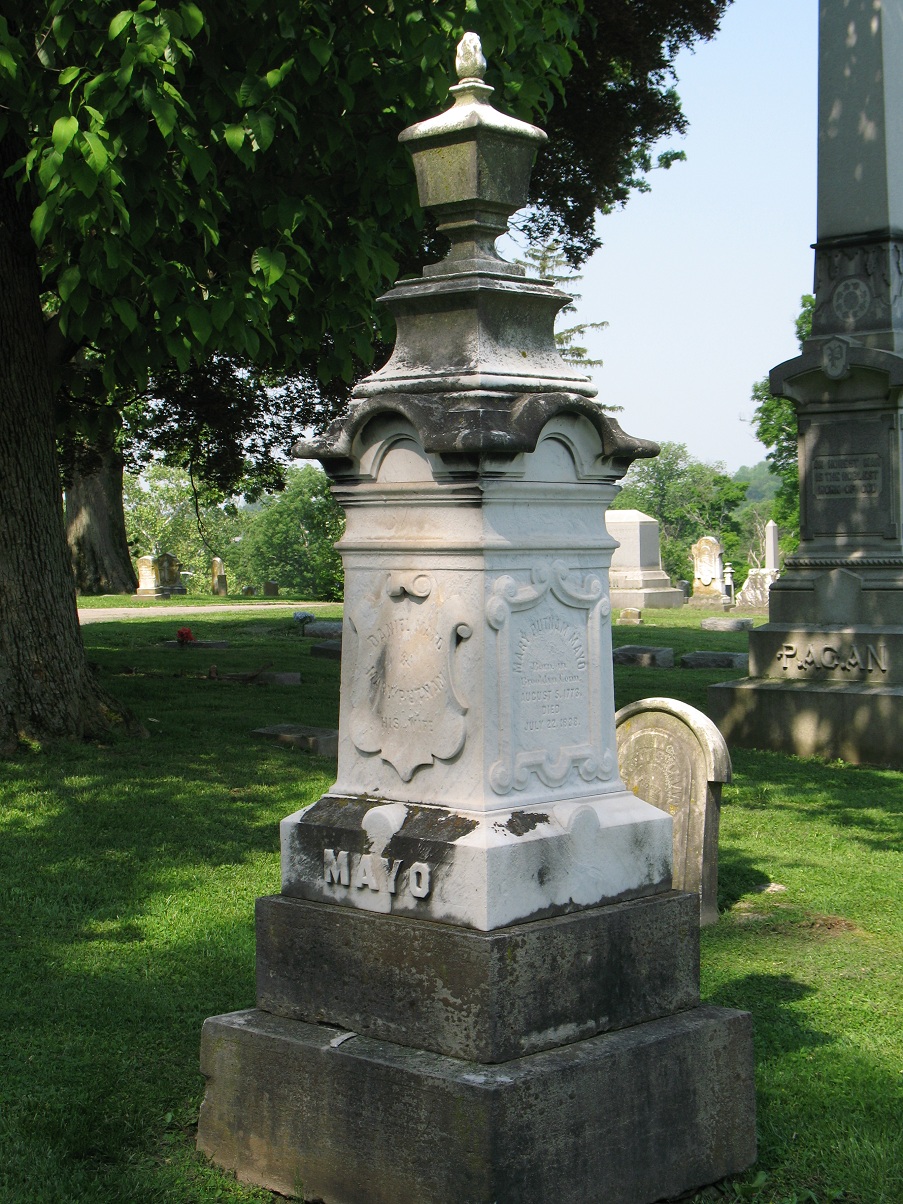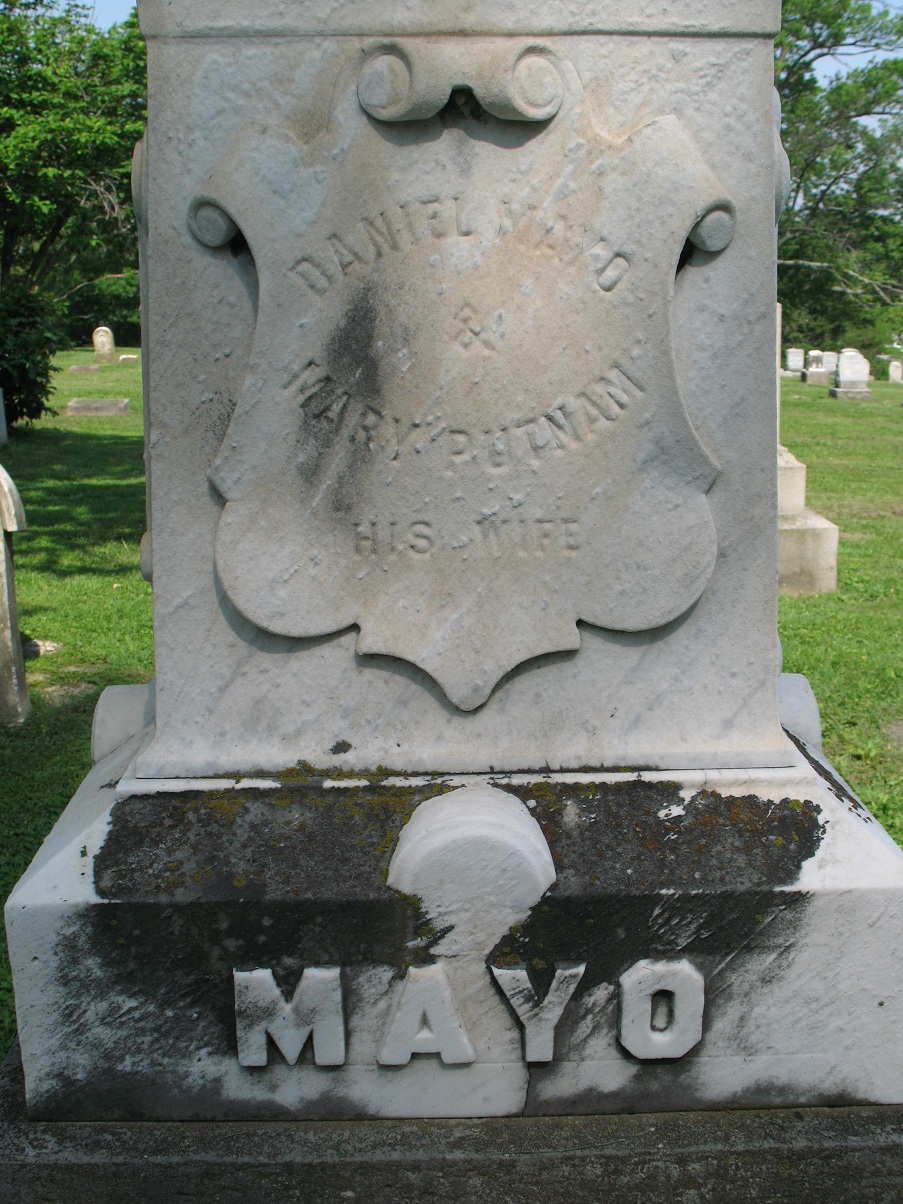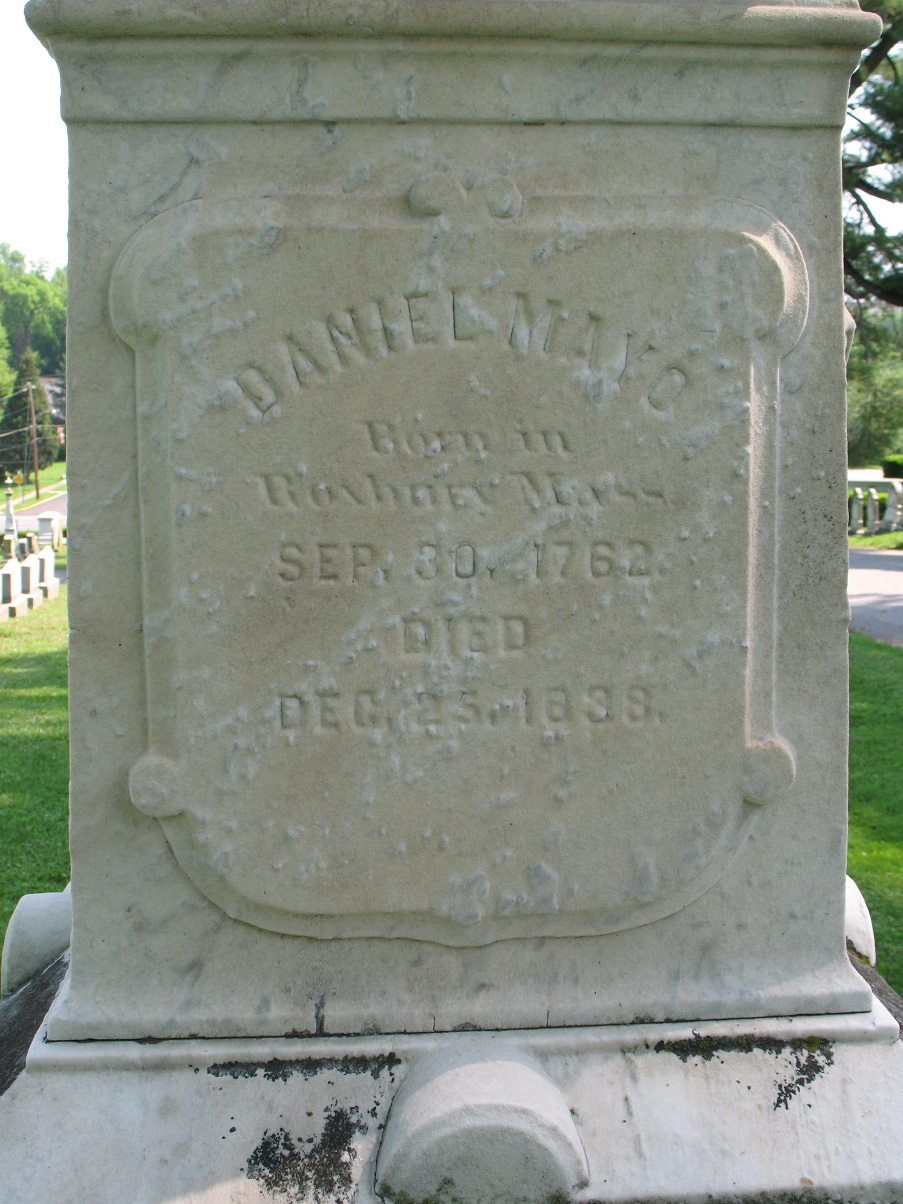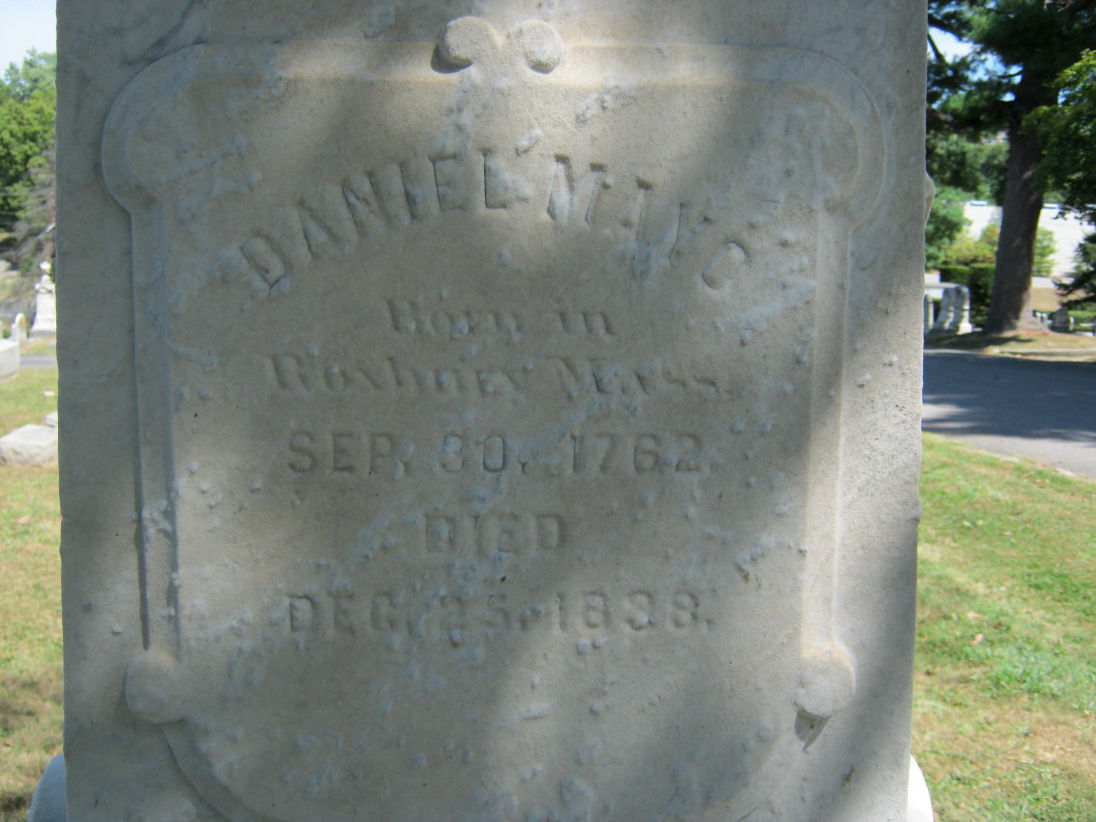Daniel attended Harvard College, where he was a classmate of John Quincy Adams; they were members of the class of 1787. In addition to Adams, other prominent names among the graduating class that year included Cranch, Judd, Kellogg, Lawrence, Learned, Putnam, Waldo, Whitney and Williams.
In 1791, young Daniel Mayo, fresh from Harvard, finds himself a school teacher living in a provisional, walled garrison on the Ohio River, called Farmer's Castle. His students were the children of settlers who, for two years or more, posted guards and established a semi-military discipline which governed all their activities.
By 1788, two tiny communities (Belpre & Marietta) had been established along the Ohio River. This was the work of a handful of Revolutionary War veterans and prospective frontier settlers from New England and the Mid-Atlantic States. In 1786, in Boston, these intrepid adventurers had formally organized an association with the goal of opening to farming a vast tract of western lands.
In the spring of 1788, the first of these homesteaders, arriving mostly as family groups, had established the community of Marietta on the Muskingum River near its outflow into the Ohio River. The war veterans, whose leader was former General Rufus Putnam, decided to name their town in honor of the French queen, Marie Antoinette, whose nation had given crucial navel aid during the American Revolution. Between 1788 and 1790 four different companies of New Englanders, composed of several dozen people - mostly families - arrived at Marietta and began to spread out from there.
The name of their second settlement was Belle Prairie, soon shortened to Belpre. Daniel Mayo arrived with either the first or the second party of the "Ohio Company of Associates." At least one record has Daniel Mayo arriving at Belpre "in the fall of 1788" and taking up teaching duties that winter.
The journey from Connecticut (the Putnam home state) was a trip of astonishing rigor and tragedy. [. . .]
In the winter of 1790-91 the settlement [of Big Bottom] was attacked and twelve pioneers were killed. A handful of terrified survivors escaped to the other settlements, which organized an armed party and found the bodies of the victims, piled inside one of the block-houses. Floor boards had been tossed on top and the building and the corpses set afire.
The settlers at Belpre responded by gathering together and building a garrison along the Ohio River, into which all of the families moved. They called their new, walled community "Farmer's Castle" and adopted a military regimen. A commander was selected; roll was called each morning. Able bodied men were mustered, given assignments and punished with extra chores for tardiness and other lapses. A flagstaff was set up and a swivel gun ("howitz") was placed on a platform and fired frequently in the spring and summer months, echoing up and down the Ohio River.
The community soon turned to the scholarly needs of its children and established a school in one of the blockhouses. The first teacher of the older children was the young, unmarried, Harvard-educated Daniel May. Daniel taught the children in Farmer's Castle during the winter months and, like the other men, spent his summers cultivating crops. Farmer's Castle seems to have been occupied until 1794. [. . .]
Before his marriage to Mary Putnam (1773-1838), Daniel Mayo left Belpre and moved to a downriver village, Losantville (renamed, thankfully, Cincinnati). Daniel's relocation seems to have been prompted by his appointment to the job of assistant postmaster at Cincinnati in about 1795. His connections to the Adams family might have facilitated this federal job, which was made during George Washington‘s presidency, when John Adams, the father of Daniel's Harvard classmate, was Vice-President.
In 1796 Daniel relinquished the postmaster appointment in Ohio but soon replaced it with a like appointment across the Ohio River in his new residence in Newport, Kentucky. Daniel held the postmaster position in Newport for the rest of his life. The 1834 City Directory for Newport lists Daniel Mayo as Postmaster with a residence at Columbia and Front Streets.
By the time Daniel moved across the river to Newport, he had begun to court young Mary Putnam, daughter of Israel Putnam Jr, one of the leaders of the Marietta/Belpre settlers. Mary preserved a letter Daniel wrote to her in their courting days, from Newport, Kentucky. [. . .]
Daniel's sentiments found their resonance with Mary, but the wedding did not take place in Belpre until October of 1798. By then, Daniel owned nine acres in Campbell County, KY. By 1800 he was listed as postmaster of Newport, KY and the owner of 24 acres. The energetic Daniel and his bride arrived in the hamlet of Newport as landowners with a government appointment to a paying federal job. No doubt, Daniel and Mary, with their "Up East" connections and accents were accepted as prominent and important newcomers in the community. [. . .]
Daniel Mayo seems to have approached life's signal events in a deliberate manner. He was 25 when he graduated from Harvard and 36 when he married. By that age, Daniel was holding the second of two federal appointments and, as stated, had acquired land in the new Commonwealth of Kentucky. Daniel's torpidity in establishing a household may be traced to a concern for security. What is known of his later life suggests a responsible, family-oriented temperament, with an eye to the future. A deed recorded on Dec 25, 1837, indicates that Daniel Mayo, near the end of his life, made a Christmas gift of a Newport city lot to each of his four children "for love and consideration of $1.00." [. . .]
Mary Putnam and Daniel Mayo had four children: Daniel Dudley, Henry Hunt (1810-1877), Mary Aurelia (1811-1844) and Harriet. The 1840 Newport census lists sons Daniel Dudley Mayo as a farmer, with a residence on Front Street, near Cabot St. Henry Hunt Mayo is enrolled as a dry goods merchant, with a residence on Taylor Street.
But a shadow of abuse and predation hangs over the picture of an otherwise admirable family making decent, exemplary lives on the western frontier. [. . .] In October 1802, Daniel Mayo bought a woman. [. . .]
Late in life, former President John Quincy Adams wrote to Daniel Mayo. Adams was then (uniquely among all former Presidents) a member of Congress.[. . .] In 1837, Adams penned a friendly letter to his Harvard classmate of fifty years before:
Daniel Mayo, Esqr, Newport, KY,
Washington, 22 March 1837
My good old friend and Classmate:
[. . .]
We are drawing toward the close of our career. Most of our classmates have gone before us. I think there is not one third part of our class remaining. [. . .] I attended Commencement about four years hence at Cambridge, but sought In vain for one classmate but found none. I have since that time lost all taste for Commencements and have not attended another.[. . .]
I shall be happy to hear from you always at your leisure and especially whenever you can give me good tidings of your welfare and that of your family. Being always in Memory of the days of yore, your friend and fellow student, J.Q Adams
Former President Adams' salute was timely sent. Daniel Mayo died the following year at age 76. Daniel and Mary Mayo both died in 1838, the 40th year after their marriage. Daniel died on July 22, Mary on Christmas Day. They were buried at the old Newport Cemetery on Ringgold Street. As the town grew, this cemetery was closed and all the graves, supposedly, were moved. Daniel and Mary Mayo's graves are marked today in Sec 4, lot 31-32 in the nearby Evergreen Cemetery, 5 Alexandria Pike, Southgate, Campbell County Kentucky.
_____________
This brief biography is a portion of a larger one, taken from Volume I of a book of family history entitled ALL OF THE ABOVE I by Richard Baldwin Cook. For additional information, visit the contributor profile, #47181028.
Daniel attended Harvard College, where he was a classmate of John Quincy Adams; they were members of the class of 1787. In addition to Adams, other prominent names among the graduating class that year included Cranch, Judd, Kellogg, Lawrence, Learned, Putnam, Waldo, Whitney and Williams.
In 1791, young Daniel Mayo, fresh from Harvard, finds himself a school teacher living in a provisional, walled garrison on the Ohio River, called Farmer's Castle. His students were the children of settlers who, for two years or more, posted guards and established a semi-military discipline which governed all their activities.
By 1788, two tiny communities (Belpre & Marietta) had been established along the Ohio River. This was the work of a handful of Revolutionary War veterans and prospective frontier settlers from New England and the Mid-Atlantic States. In 1786, in Boston, these intrepid adventurers had formally organized an association with the goal of opening to farming a vast tract of western lands.
In the spring of 1788, the first of these homesteaders, arriving mostly as family groups, had established the community of Marietta on the Muskingum River near its outflow into the Ohio River. The war veterans, whose leader was former General Rufus Putnam, decided to name their town in honor of the French queen, Marie Antoinette, whose nation had given crucial navel aid during the American Revolution. Between 1788 and 1790 four different companies of New Englanders, composed of several dozen people - mostly families - arrived at Marietta and began to spread out from there.
The name of their second settlement was Belle Prairie, soon shortened to Belpre. Daniel Mayo arrived with either the first or the second party of the "Ohio Company of Associates." At least one record has Daniel Mayo arriving at Belpre "in the fall of 1788" and taking up teaching duties that winter.
The journey from Connecticut (the Putnam home state) was a trip of astonishing rigor and tragedy. [. . .]
In the winter of 1790-91 the settlement [of Big Bottom] was attacked and twelve pioneers were killed. A handful of terrified survivors escaped to the other settlements, which organized an armed party and found the bodies of the victims, piled inside one of the block-houses. Floor boards had been tossed on top and the building and the corpses set afire.
The settlers at Belpre responded by gathering together and building a garrison along the Ohio River, into which all of the families moved. They called their new, walled community "Farmer's Castle" and adopted a military regimen. A commander was selected; roll was called each morning. Able bodied men were mustered, given assignments and punished with extra chores for tardiness and other lapses. A flagstaff was set up and a swivel gun ("howitz") was placed on a platform and fired frequently in the spring and summer months, echoing up and down the Ohio River.
The community soon turned to the scholarly needs of its children and established a school in one of the blockhouses. The first teacher of the older children was the young, unmarried, Harvard-educated Daniel May. Daniel taught the children in Farmer's Castle during the winter months and, like the other men, spent his summers cultivating crops. Farmer's Castle seems to have been occupied until 1794. [. . .]
Before his marriage to Mary Putnam (1773-1838), Daniel Mayo left Belpre and moved to a downriver village, Losantville (renamed, thankfully, Cincinnati). Daniel's relocation seems to have been prompted by his appointment to the job of assistant postmaster at Cincinnati in about 1795. His connections to the Adams family might have facilitated this federal job, which was made during George Washington‘s presidency, when John Adams, the father of Daniel's Harvard classmate, was Vice-President.
In 1796 Daniel relinquished the postmaster appointment in Ohio but soon replaced it with a like appointment across the Ohio River in his new residence in Newport, Kentucky. Daniel held the postmaster position in Newport for the rest of his life. The 1834 City Directory for Newport lists Daniel Mayo as Postmaster with a residence at Columbia and Front Streets.
By the time Daniel moved across the river to Newport, he had begun to court young Mary Putnam, daughter of Israel Putnam Jr, one of the leaders of the Marietta/Belpre settlers. Mary preserved a letter Daniel wrote to her in their courting days, from Newport, Kentucky. [. . .]
Daniel's sentiments found their resonance with Mary, but the wedding did not take place in Belpre until October of 1798. By then, Daniel owned nine acres in Campbell County, KY. By 1800 he was listed as postmaster of Newport, KY and the owner of 24 acres. The energetic Daniel and his bride arrived in the hamlet of Newport as landowners with a government appointment to a paying federal job. No doubt, Daniel and Mary, with their "Up East" connections and accents were accepted as prominent and important newcomers in the community. [. . .]
Daniel Mayo seems to have approached life's signal events in a deliberate manner. He was 25 when he graduated from Harvard and 36 when he married. By that age, Daniel was holding the second of two federal appointments and, as stated, had acquired land in the new Commonwealth of Kentucky. Daniel's torpidity in establishing a household may be traced to a concern for security. What is known of his later life suggests a responsible, family-oriented temperament, with an eye to the future. A deed recorded on Dec 25, 1837, indicates that Daniel Mayo, near the end of his life, made a Christmas gift of a Newport city lot to each of his four children "for love and consideration of $1.00." [. . .]
Mary Putnam and Daniel Mayo had four children: Daniel Dudley, Henry Hunt (1810-1877), Mary Aurelia (1811-1844) and Harriet. The 1840 Newport census lists sons Daniel Dudley Mayo as a farmer, with a residence on Front Street, near Cabot St. Henry Hunt Mayo is enrolled as a dry goods merchant, with a residence on Taylor Street.
But a shadow of abuse and predation hangs over the picture of an otherwise admirable family making decent, exemplary lives on the western frontier. [. . .] In October 1802, Daniel Mayo bought a woman. [. . .]
Late in life, former President John Quincy Adams wrote to Daniel Mayo. Adams was then (uniquely among all former Presidents) a member of Congress.[. . .] In 1837, Adams penned a friendly letter to his Harvard classmate of fifty years before:
Daniel Mayo, Esqr, Newport, KY,
Washington, 22 March 1837
My good old friend and Classmate:
[. . .]
We are drawing toward the close of our career. Most of our classmates have gone before us. I think there is not one third part of our class remaining. [. . .] I attended Commencement about four years hence at Cambridge, but sought In vain for one classmate but found none. I have since that time lost all taste for Commencements and have not attended another.[. . .]
I shall be happy to hear from you always at your leisure and especially whenever you can give me good tidings of your welfare and that of your family. Being always in Memory of the days of yore, your friend and fellow student, J.Q Adams
Former President Adams' salute was timely sent. Daniel Mayo died the following year at age 76. Daniel and Mary Mayo both died in 1838, the 40th year after their marriage. Daniel died on July 22, Mary on Christmas Day. They were buried at the old Newport Cemetery on Ringgold Street. As the town grew, this cemetery was closed and all the graves, supposedly, were moved. Daniel and Mary Mayo's graves are marked today in Sec 4, lot 31-32 in the nearby Evergreen Cemetery, 5 Alexandria Pike, Southgate, Campbell County Kentucky.
_____________
This brief biography is a portion of a larger one, taken from Volume I of a book of family history entitled ALL OF THE ABOVE I by Richard Baldwin Cook. For additional information, visit the contributor profile, #47181028.
Family Members
Advertisement
Explore more
Sponsored by Ancestry
Advertisement
